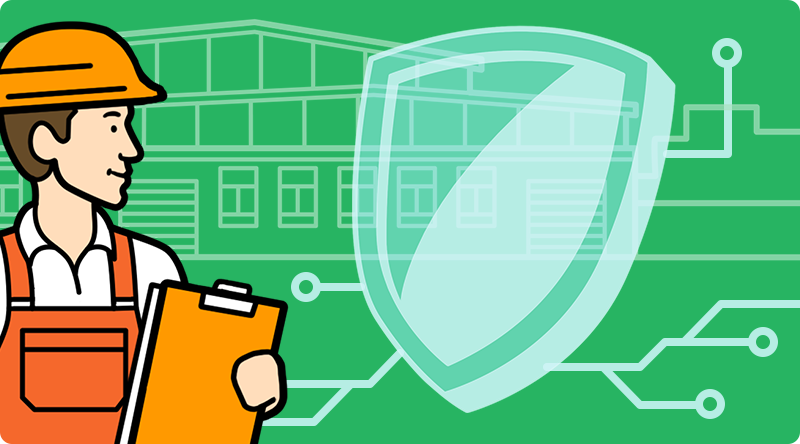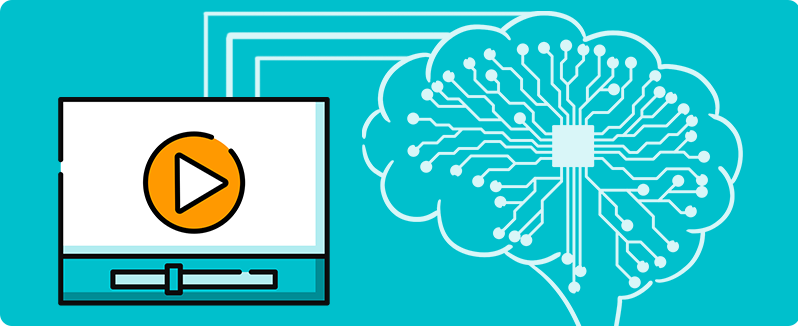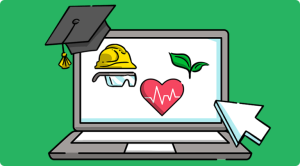The role of AI in enhancing workplace safety compliance
Written by Sophie Miller | 20th March 2024

In an era where technological innovation shapes every aspect of our lives, how is Artificial Intelligence (AI) transforming the landscape of workplace safety and compliance? AI has ushered in a new age of efficiency and precision, but its role in ensuring a safe working environment is perhaps one of its most critical applications.
From real-time hazard detection to compliance and documentation, let’s learn how businesses can leverage this technology to protect their most valuable asset: their workforce.

AI-Driven Safety Monitoring
Advancements in AI have revolutionized how safety is monitored at work, ensuring you’re protected on multiple fronts.
Wearable Safety Technology
Wearable devices equipped with AI enhance personal safety by monitoring vital signs and environmental conditions. These gadgets alert you to dangerous exposure levels or physiological stress, enabling a quick response to prevent harm. Your safety gear becomes smarter, adapting to real-time data to safeguard your well-being.
Automated Safety Training Modules
AI can also personalize safety training, offering modules based on the specific risks of an individual’s role or past incidents. This ensures that employees receive relevant, up-to-date information and training, maximizing awareness and preparedness.
Robotics for Hazardous Work
Robots, controlled by AI, are increasingly deployed in environments too dangerous for humans. These robots can perform tasks in hazardous conditions, such as extreme temperatures, toxic atmospheres, or at great heights, significantly reducing human exposure to dangerous situations.
AI in Emergency Response Planning
AI algorithms help in creating and optimizing emergency response plans. AI can suggest the most efficient evacuation routes and strategies by analyzing facility layouts, employee locations, and potential hazards, enhancing safety during critical situations.
Real-Time Hazard Detection
AI-powered cameras and sensors now play a crucial role in spotting potential hazards as they occur. These tools continuously scan the environment, detecting anything from spills to equipment malfunctions. By notifying safety personnel instantly, interventions can happen swiftly, reducing the risk of accidents.
Predictive Analytics for Accident Prevention
Through predictive analytics, AI anticipates possible incidents before they occur by analyzing patterns in historical data. You can benefit from workplace safety technology by adapting AI employee health and safety software, which utilizes extensive datasets to foresee and alert about potential safety violations, ensuring proactive measures are in place.

AI in Crafting Safety Training Videos
Integrating Artificial Intelligence (AI) in developing safety training videos represents a transformative approach to educating employees about workplace safety. This innovative use of AI not only customizes training content to meet the unique needs of different roles within a company but also ensures that the material remains engaging and effective.
Customized Content Creation
AI algorithms analyze job roles, historical accident data, and individual learning paces to tailor safety training videos. This personalized approach ensures that employees receive training that is directly relevant to their specific job hazards and safety protocols, increasing the effectiveness of the training.
Interactive and Engaging Learning Experiences
By leveraging AI, safety training videos can become interactive, allowing employees to engage in scenario-based learning. This method tests their knowledge and decision-making skills in real-time, providing immediate feedback that reinforces learning and improves retention.
Real-Time Updates and Adaptations
AI systems continuously update training materials based on new safety regulations, emerging workplace hazards, and changes in company policies. This ensures that safety training videos remain current and relevant, providing employees with the latest information and best practices.
Language and Accessibility Options
With AI, safety training videos can automatically be translated into multiple languages, making them accessible to a diverse workforce. Additionally, AI can adapt videos for different learning styles and needs, including options for those with visual or auditory impairments, ensuring inclusivity in safety training.
Analyzing Engagement and Effectiveness
AI tools can track how employees interact with training videos, collecting data on engagement levels, quiz scores, and areas where viewers may struggle. This information allows companies to refine and improve their training programs, ensuring they are as effective as possible in promoting a safe working environment.

AI-Enhanced Compliance and Documentation in Workplace Safety
AI technology significantly streamlines compliance and documentation processes in workplace safety, making them more efficient and accurate. Here’s how AI is transforming these critical areas:
- Streamlined Compliance Reporting:
– Automates the generation of compliance audit reports, saving time and reducing errors.
– Aggregates data from incident logs, safety checks, and training records to produce detailed reports that adhere to regulatory standards.
- Automated Documentation Management:
– Organizes, stores, and retrieves safety documentation effortlessly.
– Ensures documentation is current and accessible for audits, minimizing non-compliance risks.
- Proactive Compliance Alerts:
– Monitors changes in safety regulations, keeping businesses informed and prepared.
– Alerts businesses to regulatory updates, facilitating timely compliance adjustments.
- Tailored Compliance Strategies:
– Analyzes workplace data to suggest safety measures customized to specific operational risks.
– Ensures safety protocols are compliant and effectively address unique workplace hazards.
Frequently Asked Questions
How does AI improve workplace safety compliance in practice?
By integrating live monitoring through cameras and sensors, utilizing predictive analytics on past data, and employing intelligent automation to identify risks promptly and facilitate quicker responses and record-keeping.
Can AI personalize and keep safety training up to date?
AI customizes training materials, including safety videos, based on specific roles and past incidents. It also updates the content when regulations or hazards change, enhancing both relevance and retention.
How does AI help with real-time hazard detection and emergency response?
It detects spills, faults, and other risks as they occur and can optimize evacuation routes by analyzing layouts, locations, and potential hazards.
How can AI streamline compliance reporting and audits?
AI can enhance compliance reporting and audits by automating the creation of reports, compiling incident logs, safety checks, and training records. It also monitors regulatory updates and recommends customized safety actions, thereby minimizing mistakes and easing the audit process.
Conclusion: Embracing the Future of Workplace Safety with AI
AI’s capability to monitor environments in real-time, predict potential hazards, personalize safety training, and even take over hazardous tasks marks a significant leap forward in protecting employees. Integrating AI into safety protocols improves compliance and fosters a culture of safety that extends beyond mere adherence to regulations.
As businesses continue to navigate the challenges of ensuring a safe working environment, embracing AI as a tool for enhancing safety measures is not just a strategic move—it’s a necessary evolution towards a safer, more efficient workplace. By harnessing the power of AI, organizations can not only anticipate and mitigate risks but also create an environment where safety is ingrained in the fabric of their operations.


